Re: dimiensions.....that's what I thought. Notice that the Comet is wide enough to allow five across seating. While the sides are not curved like Amfleet, the area near the floor level is recessed about 3 inches on each side to allow clearance for the high level platforms.Airplanes don't spend their time being buffetted by dirty, sand, and rocks.
Also, the Horizon is a smaller car then the amfleet. Shorter and narrower.
More mis-information ?? the Horizon is 85 foot over coupler surface same as the Amfleet cars.
My info about speeds is the current NEC Employee timetable, not hearsay by deskjockeys.
You are using an out of date browser. It may not display this or other websites correctly.
You should upgrade or use an alternative browser.
You should upgrade or use an alternative browser.
amtrak horizon coaches
- Thread starter amtrakwolverine
- Start date

Help Support Amtrak Unlimited Discussion Forum:
This site may earn a commission from merchant affiliate
links, including eBay, Amazon, and others.
- Status
- Not open for further replies.
Green Maned Lion
Engineer
Shorter as in short-vs-tall, not short in length.Airplanes don't spend their time being buffetted by dirty, sand, and rocks.
Also, the Horizon is a smaller car then the amfleet. Shorter and narrower.
More mis-information ?? the Horizon is 85 foot over coupler surface same as the Amfleet cars.
My info about speeds is the current NEC Employee timetable, not hearsay by deskjockeys.
I wouldn't call my source a desk jockey. He's too high up, and in operations.
Last edited by a moderator:
Shorter as in short-vs-tall, not short in length.Airplanes don't spend their time being buffetted by dirty, sand, and rocks.
Also, the Horizon is a smaller car then the amfleet. Shorter and narrower.
More mis-information ?? the Horizon is 85 foot over coupler surface same as the Amfleet cars.
My info about speeds is the current NEC Employee timetable, not hearsay by deskjockeys.
I wouldn't call my source a desk jockey. He's too high up, and in operations.
you got your dimentions screwed up. lenght vs height, vs width.
tell your source to read his company governing literature, specificaly the Operating rules and employeee timetable, its the governing document.
Short indicates a lack of both length and height. Narrow indicates a lack of width.Shorter as in short-vs-tall, not short in length.Airplanes don't spend their time being buffetted by dirty, sand, and rocks.
Also, the Horizon is a smaller car then the amfleet. Shorter and narrower.
More mis-information ?? the Horizon is 85 foot over coupler surface same as the Amfleet cars.
My info about speeds is the current NEC Employee timetable, not hearsay by deskjockeys.
I wouldn't call my source a desk jockey. He's too high up, and in operations.
you got your dimentions screwed up. lenght vs height, vs width.
tell your source to read his company governing literature, specificaly the Operating rules and employeee timetable, its the governing document.
Green Maned Lion
Engineer
I didn't get my dimensions screwed up, Dutch. You misunderstood what I was referring to.you got your dimentions screwed up. lenght vs height, vs width.tell your source to read his company governing literature, specificaly the Operating rules and employeee timetable, its the governing document.
Secondarily, Dutch, there are official policies and unofficial ones. The one I am referring to is the latter. As such, it is not spelled out in the employee time tables.
M
monorailfan
Guest
I'll disagree. I'm glad the MRR has their performance way up. Now just get rid of the Horizon cars and runs Supers all the time, and I'll ride.I'll be in the minority and say that based on several trips on the Missouri River Runners and their predecesors, the Horizon cars are comfortable for 2 to 4 hours. They aren't as horrible as many seem to feel.
Dang, they have not yet put Supers on the MRR for the winter. I might not ride the MRR this year!
It's worth the $12 to ride Biz class, a nice ride from STL-KCY!!!I'll disagree. I'm glad the MRR has their performance way up. Now just get rid of the Horizon cars and runs Supers all the time, and I'll ride.I'll be in the minority and say that based on several trips on the Missouri River Runners and their predecesors, the Horizon cars are comfortable for 2 to 4 hours. They aren't as horrible as many seem to feel.
Dang, they have not yet put Supers on the MRR for the winter. I might not ride the MRR this year!
sunchaser
Conductor
Hi guys-
Can you post some pictures of both? Exterior & interior please?
Also, what rouutes are they on?
I know these sound like dumb questions, but I have never been back east so I'd like to see what you guys are talking about!
Thanks!
Can you post some pictures of both? Exterior & interior please?
Also, what rouutes are they on?
I know these sound like dumb questions, but I have never been back east so I'd like to see what you guys are talking about!
Thanks!
cpamtfan
OBS Chief
Hi guys-Can you post some pictures of both? Exterior & interior please?
Also, what rouutes are they on?
I know these sound like dumb questions, but I have never been back east so I'd like to see what you guys are talking about!
Thanks!
Just about every corridor route out of CHI (with the exception of STL-KSC), I believe on one of the corridor trains in California (where the cars were originally based, on San Joaquin and Capitol Corridor runs).
The only exceptions are that some Amfleets (aka cars from the NEC) are suppliments, as well as Superliners on the Michigan trains in the winter due to freezingt problems on the single level equipment.
TVRM610
Conductor
economy sleepers in an amfleet? do tell please....I have always been partial to Budd equipment including Amfleet, but the straight sides of the Horizons seems to me to be not as stylish as Amfleet, but more practicle. The overhead baggage racks can be further apart and/or deeper than the Amfleets. Years ago, when they experimented with those economy sleeper rooms on an Amfleet car for the Shenandoah, they would have had more space for them.
If the Horizons are constructed of aluminum, why can't they be polished to gleam, similar to the unpainted finish on American Airlines aircraft?
Green Maned Lion
Engineer
Horizon:
Business Class Interior

Coach interior
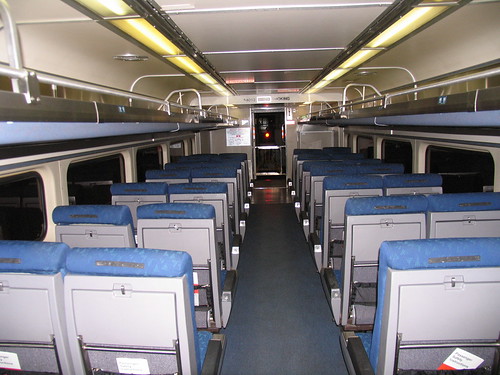
Exterior
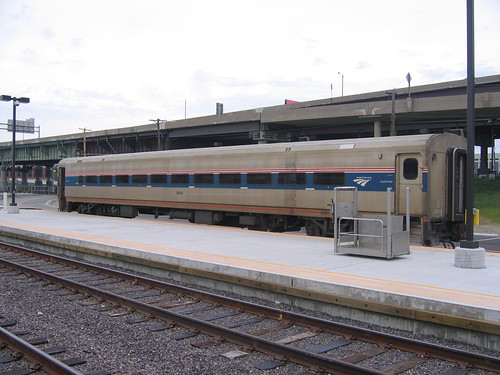
Amfleet:
Interior

Amfleet II

Amfleet I

The Horizons are designed for corridor services with low-stop frequency, as they have manually operated doors. They are based off of the NJDOT-specified Pullman-Standard "Comet" cars built for the Erie Lackawana to replace their ancient, unairconditioned coaches. These cars were piggybacked on NJT's order of Comet II cars, which have trap doors that allow it to operate on both high level and low level platforms, and were built by Bombardier. They were purchased primarily because they were cheap.
Business Class Interior

Coach interior

Exterior

Amfleet:
Interior

Amfleet II

Amfleet I

The Horizons are designed for corridor services with low-stop frequency, as they have manually operated doors. They are based off of the NJDOT-specified Pullman-Standard "Comet" cars built for the Erie Lackawana to replace their ancient, unairconditioned coaches. These cars were piggybacked on NJT's order of Comet II cars, which have trap doors that allow it to operate on both high level and low level platforms, and were built by Bombardier. They were purchased primarily because they were cheap.
Green Maned Lion
Engineer
The NJ Transit version had manually operated end doors (now automatic, like the ones you find on Amtrak) and automatic-operated exterior doors (like you find on Amfleet Is and Surfliner/California cars). The cars were always designed with centrally operated exterior doors, which is why the Amtrak version, which has the reverse (manually operated exterior doors, automatic interior doors, corresponding with more longer-distance operation) does not have stairway traps. On the NJ Transit cars, the stairs are covered over by a sliding door when the doors are closed. Lacking that door, the Amtrak version is always exposed.
The Comet I could only operate on low-level platforms, for it had no trap and had a lower door opening.
Comet I:

Comet IIs corrected that problem for service on lines other than the Erie Lackawanna (all low platform) such as the Northeast Corridor and North Jersey Cost Line, by using trap doors and a long sliding door covering the stairs. It was also, to my knowledge, the first car that could operate with its exterior door closed and its trap door opened- which really simplifies train operation. They were what the Horizon is based on and were built by Bombardier.
Comet II:

The Comet III was similar to the Comet II but had a pair of centrally located automatic exterior doors, similar to subway cars, which speed boarding at high level platforms, also built by Bombardier:
Comet III:
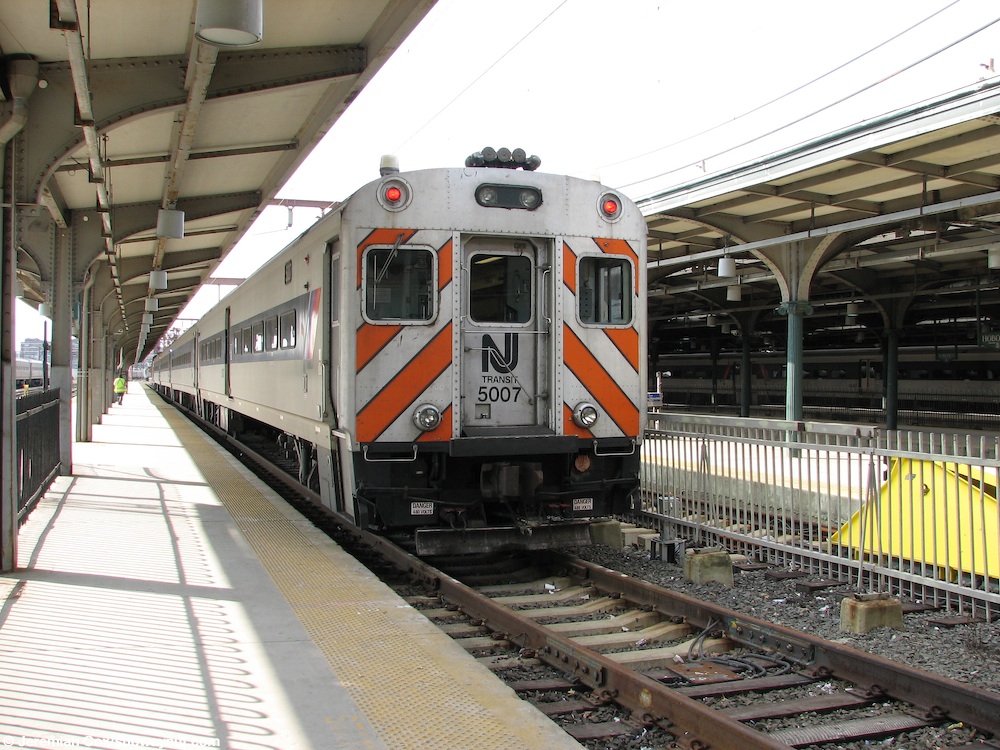
The Comet IV is an improved Comet III, the main difference is found in the cab cars, which do not have cab-side doors, persuant to the safety findings of a train collision in Secaucus, NJ. They are also Bombardier-built.
Comet IV:
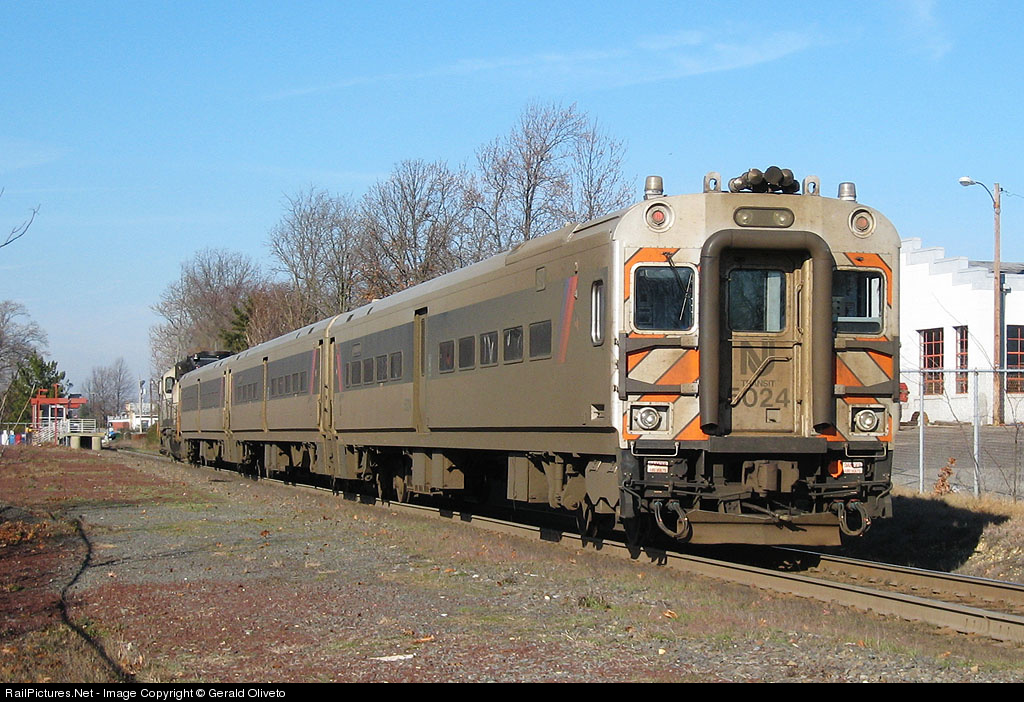
The last car using the Comets basic shape is the Comet V. I'm not sure how technically related to the original series it is. The original Comets were built from Aluminum, and were built by Pullman-Standard, followed by Bombardier who bought out the design. The next set of cars, referred to as Comet Vs, are very different. They have much larger windows, their air conditioners are located on top of the car, rather than in the roof, and they are built out of stainless steel. They are also built by the Anglo-French company Alstom rather than the Canadian Bombardier
Comet V:

Their replacement is entirely unrelated, its a bi-level car sometimes referred to as the Comet Multi-level. I think NJ Transit has refrained from this practice, which makes sense- it isn't related to the comet in the slightest:

The Comet I could only operate on low-level platforms, for it had no trap and had a lower door opening.
Comet I:

Comet IIs corrected that problem for service on lines other than the Erie Lackawanna (all low platform) such as the Northeast Corridor and North Jersey Cost Line, by using trap doors and a long sliding door covering the stairs. It was also, to my knowledge, the first car that could operate with its exterior door closed and its trap door opened- which really simplifies train operation. They were what the Horizon is based on and were built by Bombardier.
Comet II:

The Comet III was similar to the Comet II but had a pair of centrally located automatic exterior doors, similar to subway cars, which speed boarding at high level platforms, also built by Bombardier:
Comet III:

The Comet IV is an improved Comet III, the main difference is found in the cab cars, which do not have cab-side doors, persuant to the safety findings of a train collision in Secaucus, NJ. They are also Bombardier-built.
Comet IV:

The last car using the Comets basic shape is the Comet V. I'm not sure how technically related to the original series it is. The original Comets were built from Aluminum, and were built by Pullman-Standard, followed by Bombardier who bought out the design. The next set of cars, referred to as Comet Vs, are very different. They have much larger windows, their air conditioners are located on top of the car, rather than in the roof, and they are built out of stainless steel. They are also built by the Anglo-French company Alstom rather than the Canadian Bombardier
Comet V:

Their replacement is entirely unrelated, its a bi-level car sometimes referred to as the Comet Multi-level. I think NJ Transit has refrained from this practice, which makes sense- it isn't related to the comet in the slightest:

Green Maned Lion
Engineer
They built a few modules, similar to the Superliner Roomettes, for an Amfleet. They were used in a car on a few Harley Staggers Specials, a unique Amfleet Cafe/dinette/sleeper/coach thingie. I think there was never more than three cars on the train, a baggage, that thing, and a coach.economy sleepers in an amfleet? do tell please....
Actually, the Amfleet shell is pretty adaptive. To whit:
Metroliner EMUs:
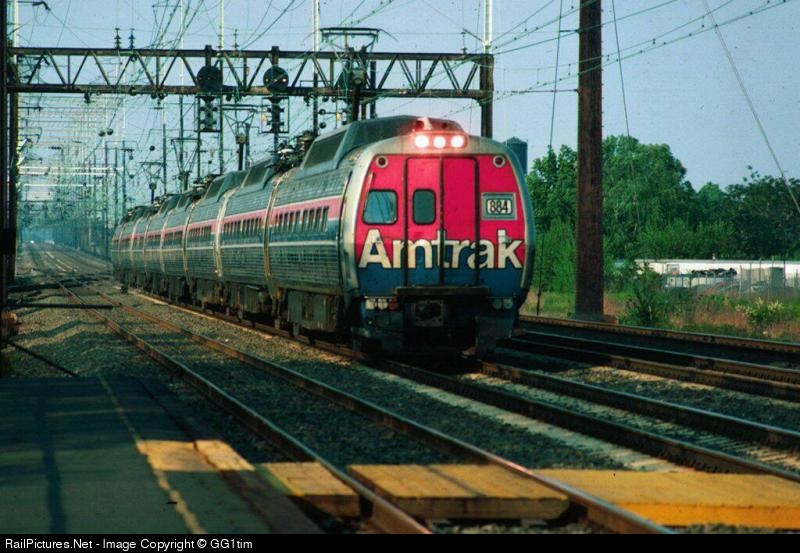
Amfleet I short-distance, Amfleet II long-distance, and the SPV 2000 DMUS, seen here as cab-car on the New Haven Shoreline East:

And as a Budd demonstrator:

which I think especially attractive.
By the way, Sunchaser, notice the Amfeet IIs manual side doors and its larger windows. It was intended as a medium-distance coach, for things like the Palmetto and Carolinian. The true long-distance coach was concieved as a variation of the Viewliner design.
OlympianHiawatha
Engineer
GREAT pics GML. I especially like the shovel nose Budd demo unit. And at a fast glance, the Comet Vs almost look like a subway/elevated car.
sunchaser
Conductor
Thanks for posting all those great pictures with info about them! It really helps to see them labeled & see the interiors too!
Since I've only been on Superliners, I wasn't positive what an Amfleet looked like versus the Horizon cars. I think I like the look of the Horizons & Comet in general, but have no idea if they're a better car or ride. The Comet multilevel was pretty good looking too. The Amfleets remind me of an aluminum tube!
Since I've only been on Superliners, I wasn't positive what an Amfleet looked like versus the Horizon cars. I think I like the look of the Horizons & Comet in general, but have no idea if they're a better car or ride. The Comet multilevel was pretty good looking too. The Amfleets remind me of an aluminum tube!
Green Maned Lion
Engineer
I've come to like the Multilevels as commuter cars- I wasn't sure at first - but they are rotten for Amtrak's needs. You have to walk up and down stairs to move through the train.
PaulM
Engineer
As I chime in whenever this topic comes up, I'm also in the minority. But more to the point, I'm glad the people along the Illinois Zephyr / Carl Sandberg route don't feel the same way as monorailfan. It's a great service regardless of the type of coach; and I would hate to see it die because everyone is waiting for superliners.I'll disagree. I'm glad the MRR has their performance way up. Now just get rid of the Horizon cars and runs Supers all the time, and I'll ride.I'll be in the minority and say that based on several trips on the Missouri River Runners and their predecesors, the Horizon cars are comfortable for 2 to 4 hours. They aren't as horrible as many seem to feel.
Dang, they have not yet put Supers on the MRR for the winter. I might not ride the MRR this year!
Incidentally, I believe the 2-1 BC / cafe cars on this line are Amfleets, not Horizons. And I have never found any difference in the ride quality between the coaches and the BC/Cafe car.
M
monorailfan
Guest
The MRR seems to be a grab bag. Sometimes it is Amfleets, usually Horizon or a mix of both. In the winters, they usually run Supers (but not yet this year). Yes, I've been spoiled by Supers. I freely admit it. I also will admit that it IS a good thing most of the MRR riders don't feel the way I do, or our MRR service would dry up. I should just be glad Missouri has what it has.As I chime in whenever this topic comes up, I'm also in the minority. But more to the point, I'm glad the people along the Illinois Zephyr / Carl Sandberg route don't feel the same way as monorailfan. It's a great service regardless of the type of coach; and I would hate to see it die because everyone is waiting for superliners.I'll disagree. I'm glad the MRR has their performance way up. Now just get rid of the Horizon cars and runs Supers all the time, and I'll ride.I'll be in the minority and say that based on several trips on the Missouri River Runners and their predecesors, the Horizon cars are comfortable for 2 to 4 hours. They aren't as horrible as many seem to feel.
Dang, they have not yet put Supers on the MRR for the winter. I might not ride the MRR this year!
Incidentally, I believe the 2-1 BC / cafe cars on this line are Amfleets, not Horizons. And I have never found any difference in the ride quality between the coaches and the BC/Cafe car.
Yep - I am a proud, spoiled Superliner fan........just like others railfans are with the loco builders. Chevy/Ford thing. Time to get rid of the Horizons and Amcans....
But I'm not just a railfan, rather a tranportation fan. I'm the same way about flights - there are only a few airlines/airplanes that I will travel on.
TVRM610
Conductor
I'm quite fond of the NJT multi-levels... if you sit in the non-locomotive end (wether trailing or leading) you get a terrific ride of swaying especially over turn-outs on the non NEC lines... WHAT FUN! Seriously though, these cars are super quite and super smooth compared to all of the comets, they are very nice.I've come to like the Multilevels as commuter cars- I wasn't sure at first - but they are rotten for Amtrak's needs. You have to walk up and down stairs to move through the train.
zoltan
Service Attendant
- Joined
- Sep 6, 2008
- Messages
- 230
So THAT'S why the amfleets and other coaches have the stange spring-loaded (I think) steps arrangement! I had never known why. You learn something new every day!1. Stairs are exposed to the elements. That means in winter they freeze which is both a work and passenger hazard.
The foldaway step design, I believe, came out in the lightweight streamliner cars of the 1930's to also improve the aesthetics of the car, with the added benefit of less drag from air turbulence when travelling at high speeds of that era of around 90-100 mph. The cars sometimes featured 'skirts' that could be raised for access to undercar mechanical components.So THAT'S why the amfleets and other coaches have the stange spring-loaded (I think) steps arrangement! I had never known why. You learn something new every day!1. Stairs are exposed to the elements. That means in winter they freeze which is both a work and passenger hazard.
Green Maned Lion
Engineer
I've been digging all over for information on those cars, including FOIAs to Amtrak themselves. To no avail.GML, Add me to those thanking you for those great photos. I wonder if you or anyone else might have an interior photo of those Amsleeper rooms?
Realize now that somebody is going to be Googling "raised" and "skirts" while looking for porn and get a link to this page instead.The cars sometimes featured 'skirts' that could be raised for access to undercar mechanical components.
rtabern
Conductor
The biggest problem is the stairs that are on the outside of the body... exposed to the elements and everything. They run that equipment from here (Milwaukee) to Chicago and they have to clean off the stairs everytime at every stop from the snow and ice and they are still often very slick. I say ship the equipment to the west coast or south or something and use bi-levels up here in the Midwest. There are no real stairs outside the Superliners and would be a lot better to use on the routes here.
- Status
- Not open for further replies.


